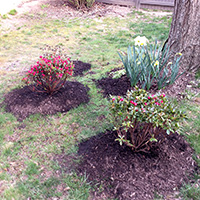As the New Year Approaches

The year was successful - more or less as it always is with gardening. The daffodils lit up the spring, though two sections did not come up and had to be replanted in the fall. The Marieke were especially resplendent. The fern garden did well throughout the spring and summer. The sweet woodruff was invasive, but manageable. The Helebore left over from the previous gardeners was small but sweet. Phlox and allium added color at the end of the summer and the chrysanthemums grew into large balls in the fall.

Harry Lauder's walking stick and its companions did relatively well this year. One of the Mexican sage bushes passed away unceremouniously. I replaced it with a beautiful rosemary plant that flourished except for several stalks that died for no apparent reason. The lavender did well as did the false indigo. Especially attractive this year was the angelonia and Moses in the cradle (see below)
One of the beautyberry plants set berries nicely, thought they fell off early in the fall, while the other set only a few. Maybe with maturity they will be more prolific. The lilacs bloomed for the first time. Two plants that I transplanted from St. James in the fall were destroyed by deer. They may or may not survive. This year, for the first time, I managed to tame the short strethch of hedge next to the deck of the cottage. I even brought the pachysandra in front of the hedge to heel. Most notably, I seeded the section of the back yard north of the patio.









.jpg)



















 I transplanted the tomatoes into deeper pots with the intention of stimulating more robust root systems, a tip I took from Jeff Cox's 100 Greatest Garden Ideas. The seeds I planted outdoors on March 8 have sprouted and seem to be enduring the cold. As I predicted, a neighborhood cat is playing havoc with them —using the garden as a cat pan.
I transplanted the tomatoes into deeper pots with the intention of stimulating more robust root systems, a tip I took from Jeff Cox's 100 Greatest Garden Ideas. The seeds I planted outdoors on March 8 have sprouted and seem to be enduring the cold. As I predicted, a neighborhood cat is playing havoc with them —using the garden as a cat pan.




















































 We (William and I) also washed, scraped and painted parts of the fence. We (Wendy and I) had the house power washed, stained and the trim repainted ($8,000) and the driveway resealed ($145).
We (William and I) also washed, scraped and painted parts of the fence. We (Wendy and I) had the house power washed, stained and the trim repainted ($8,000) and the driveway resealed ($145).





































 matched by the purple basil that sprouted here and there. The morning glories (at least those on the trellis) are in bloom as are the New England asters we rescued from the church field.
matched by the purple basil that sprouted here and there. The morning glories (at least those on the trellis) are in bloom as are the New England asters we rescued from the church field.















 and a veronica, which would go well with the eryngium I bought last year. I got both, plus a parsley plant, a hanging basket of ivy geranium, a bag of
and a veronica, which would go well with the eryngium I bought last year. I got both, plus a parsley plant, a hanging basket of ivy geranium, a bag of 


















































